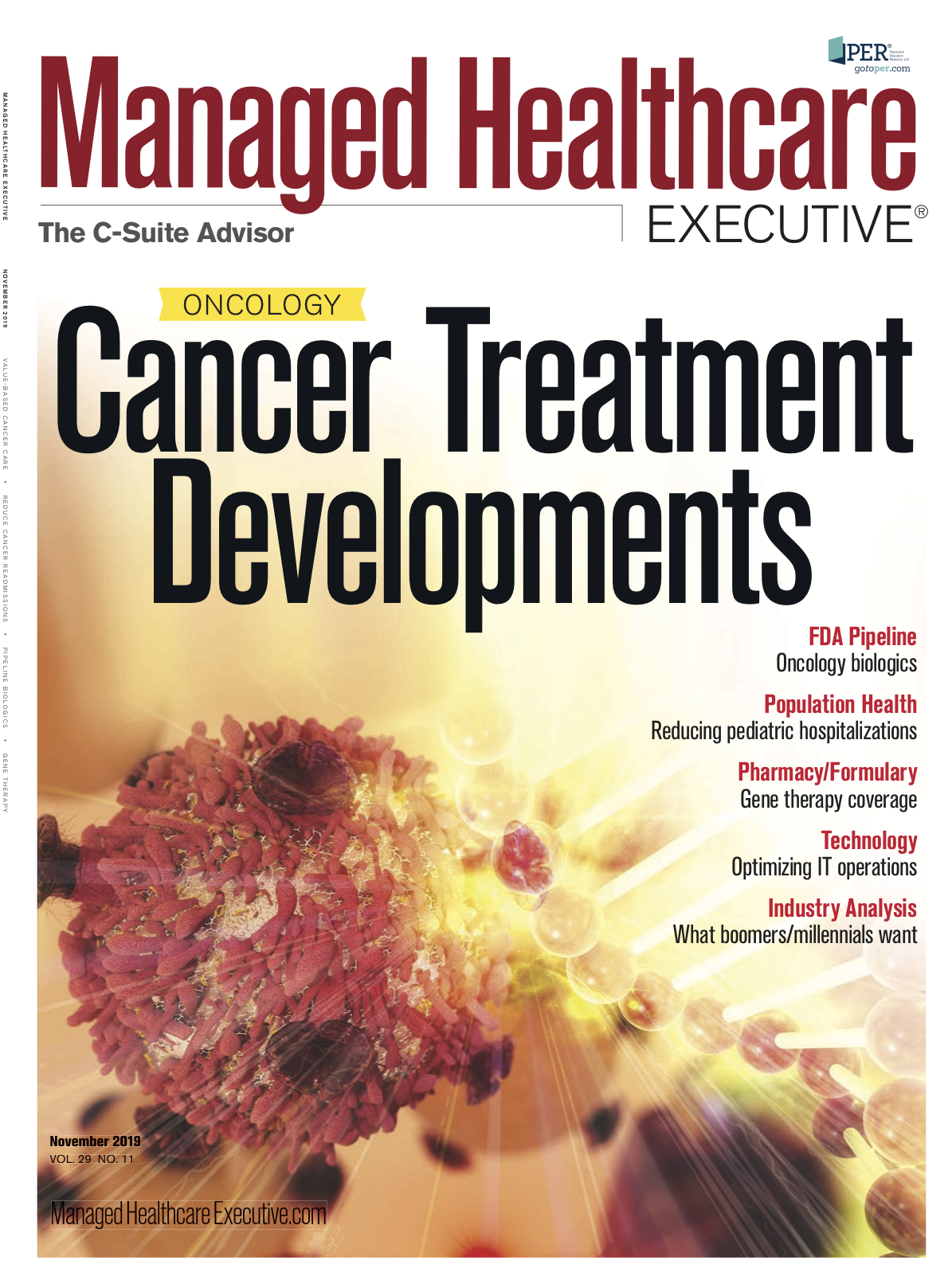Approaches to Cancer Pain Management
There are a variety of ways, but a multi-pronged approach is best.

Cancer-related pain doesn’t always stop when active treatment ends. Patients with stabilized disease or in remission are living longer due to earlier detection and better treatments. Managing chronic pain (six months or longer) is increasingly important. About 5% of the U.S. population are cancer survivors, 15.5 million people, according to “Pain in Cancer Survivors: How to Manage,” June 2019, Current Treatments in Oncology. Cancer-related pain can be from the disease itself, or due to treatment. Most cancer patients will experience pain at some point during their illness, says Jacob Strand, MD, chair of palliative care medicine at the Mayo Clinic in Rochester, Minnesota. About 80% to 90% of those with metastases, who are incurable, will have cancer-related pain, Strand says, as will up to 40% of cancer survivors overall.
Ideally, treating pain involves a multi-prong approach. That might mean some combination of physical therapy, behavioral therapy, blocks/injections, and medication. Not all health insurance covers an extensive approach, though undertreating pain impacts a patient’s health and quality of life substantially. As patients live longer after active treatment, oncologists see the patients less, leaving pain management in the hands of primary care physicians (PCP), who may not feel equipped to treat it.
Cancer pain assessment
A typical assessment for pain management includes pain assessment, functional assessment, and then risk assessment, says Judith Paice, PhD, RN, director of the Cancer Pain Program in the Hematology-Oncology division at Northwestern University in Chicago.
The risk assessment is newer and still not performed by most oncologists, Paice says. It includes questions about smoking, alcohol use, and prescription substance use not as prescribed. It also includes a family history of substance abuse to give a “crude understanding of genetic risk” and to understand what substance issues might exist in the home. She takes all the answers into account, while trying to determine if their pain is likely to respond to opioids, and if they’re at risk for abuse.
A cancer patient can suffer from various types of pain. Tumor-related pain can be from a tissue injury, like a mass effect from the tumor pressing against the bone or nerves. Pain can be treatment-related, like pain after surgery, or associated with radiation therapy. As radiation gets more precise, patients are experiencing less pain. “Unfortunately, pain associated with chemotherapy is increasing, as more and more agents are causing peripheral neuropathy,” Paice says. Steroid use can cause avascular necrosis and bone fragility. Aromatase inhibitors and hormonal therapies for prostate and breast cancers can cause pain. “If one in eight women with breast cancer are estrogen positive, they’re likely on aromatase inhibitors for five to 10 years,” Paice says. Stem cell transplant can lead to graft versus host disease. With new treatments always arising, pain management is a moving target, she says.
Assessing and treating function, not pain severity
Pain used to be assessed and treated based on intensity scores, with patients rating their pain on a 0-10 scale, and trying to lower the pain to a different number. That is changing. Clinicians are now focused on functionality, what the patient can do after pain management that they couldn’t do before it. Clinicians ask patients about their physical and emotional goals, understanding what improved function and quality of life looks like.
Improved functionality could be performing activities of daily living that they can’t do because of pain, Strand says. “That shift is particularly important in chronic cancer-related pain, where there’s no cure for the underlying problem,” he says.
Multimodal therapy is the preferred approach. While medications work well for some, a medication may be contraindicated due to a patient’s other medical issues. And not all pain can be addressed with pharmacological treatments. Treatments like physical and occupational therapy, and cognitive behavioral therapy (CBT) are often helpful, though CBT sometimes carries a stigma. “I try to reframe it,” Paice says. She tells patients “our psychologist here is not for crazy people. It’s for normal people going through crazy times.” She tells them they are going through a difficult time, but have an inner strength that the therapist will help them find.
The idea behind using multiple interventions is to provide the best outcomes with the fewest side effects and least risk. Not all therapy types are indicated for each patient, but it’s important to consider different treatment modes. In the best scenario, patients have access to various therapies to help them move appropriately and with emotions. “It’s really tough to get all of that paid,” Paice says.
Who should treat pain management?
Five years out from cancer treatment, many patients are no longer seeing their oncologist more than once annually, if at all. Some academic medical centers develop care plans for PCPs to follow, but they mostly recommend screening practices, not pain management. That can leave PCPs in the uncomfortable position of treating cancer-related pain, without the knowledge.
“Clinicians have historically not been well trained to manage cancer pain at all stages of their diagnosis, illness, survivorship, and end of life,” Strand says. With a significant patient population with growing health needs, it’s important for all physicians and advanced practice providers to get pain management training.
Palliative care clinicians tend to see more difficult cases, Strand says, either those with a complicated medication regimen, or patients with coexisting symptoms like mood disorders, or patients with a high risk of relapse.
One concern that cancer patients have is the fear of cancer recurrence. A new pain complaint is stressful to patients, given the uncertainty of the disease returning. A clinician treating a cancer survivor for pain should be aware of that.
Types of treatments
Clinicians try to optimize use of non-opioid medications for chronic pain, Paice says. That can include nonsteroidal anti-inflammatory drugs. Steroid injections and nerve blocks are useful, especially for abdominal pain related to pancreatic cancer, says David Craig, PharmD, clinical pharmacist in pain management/palliative care at H. Lee Moffit Cancer Center in Tampa, Florida. “Drugs are not very good at managing abdominal or neuropathic pain,” he says.
But 30% to 50% of those getting antineoplastic therapy, and 75% to 90% of those with advanced disease, have pain best treated by opioids, according to UpToDate, topic updated June 2019. Opioids have received a lot of negative press lately. “Our first goal as physicians is to do no harm,” Strand says. And that means being thoughtful about how medications are used and how patients are monitored, to minimize even unintentional harm.
Not only are some clinicians reticent to prescribe opioids when indicated, but patients are afraid to take them. “We need to be really direct and ask them if they’re worried about becoming addicted,” Paice says. Patients may not take prescribed opioids out of fear, or because they receive negative messages from family members. That contributes to undertreatment of pain.
Part of Strand’s risk screening process includes checking the state prescription monitoring database, to see if the patient may be at risk for substance abuse. Closely monitoring outcomes and patient function, as opposed to pain level, helps with safer prescribing. “We can provide it safely and still manage pain effectively,” Strand says. He tells patients that part of his job is to make sure they’re safe, and that can help overcome some fear of addiction. The number of patients in his practice who benefit from opioid treatment far outweigh the number of patients harmed from it, he says. Monitoring patients with opioid prescriptions is labor intensive, requiring close communication with oncology and PCP colleagues. “Opioids for all” is not an appropriate strategy, but they’re helpful for some patients.
Clinicians disagree about the utility of cannabis in pain management. Craig does not recommend it to his patients, as he says there’s not enough data to support it, and patients think they can buy it from someone off the street, smoke it, and it will work. “We don’t disallow it, but we don’t recommend it,” he says.
A 2018 study, “Medical Oncologists’ Beliefs, Practices, and Knowledge Regarding Marijuana Used Therapeutically: A Nationally Representative Survey Study,” in the Journal of Clinical Oncology reported that up to 80% of oncologists have discussed medical cannabis use with patients, though only 30% felt informed enough to recommend it. The study, which surveyed 400 medical oncologists in 2016, showed that 67% of oncologists thought it was a helpful addition to standard pain management options. The American Cancer Society noted that some studies found that inhaled marijuana was helpful for neuropathic pain, and that those using marijuana extracts in clinical trials needed less pain medication.
Strand has comprehensive discussions with his patients about medical cannabis, as he knows patients will ask about it. He says the data on effectiveness in pain management for cancer pain is mixed. In his practice he’s seen patients benefit from it, and those who don’t. Like many treatments, clinicians need to determine how cannabis fits into treatment, and monitor it closely for side effects. “They’re not the savior to our problems with pain, but they should also not be discarded,” he says. Before a patient uses cannabis for pain management, he asks them to track it in a pain diary, just as they would with any other pain medication.
The problem with undertreatment
Undertreating pain is a problem, as is overtreatment. Pain management allows a person to be functional. “They need to move to prevent lung complications, blood clots, and improve their general quality of life,” Paice says. “We don’t want people isolated in their homes because the pain is too bad to move.” This happens due to access to care, as well as for those afraid to use opioids.
Undertreatment can also affect survival. “Sometimes symptoms that are poorly controlled can lead patients to discontinue therapy,” Strand says. He tells patients that if their pain is preventing them from getting out of their chair, they’ll have a worse outcome than if they were functional individuals.
Deborah Abrams Kaplan covers medical and practice management topics.

In the Scope of Virtual Health and the Future of “Website” Manner, Per Ateev Mehrotra
August 10th 2023Briana Contreras, an editor of Managed Healthcare Executive, had the pleasure of catching up with MHE Editorial Advisory Board Member, Ateev Mehrotra, MD, MPH, who is a professor of healthcare policy at Harvard Medical School and an Associate Professor of Medicine and Hospitalist at Beth Israel Deaconess Medical Center.
Listen
David Calabrese of OptumRx Talks New Role, Market Insulin Prices and Other Topics 'On His Mind'
April 13th 2023In this month’s episode of the "What's On Your Mind podcast," Peter Wehrwein, managing editor of MHE connects with the now Chief Clinical Officer of OptumRx Integrated Pharmacies, David Calabrese. In this conversation, David touches on his transition in January as OptumRx’s former chief pharmacy officer and market president of health plans and PBMs to his new role as Chief Clinical Officer where he now focuses more on things such as specialty pharmacy to home delivery — with an overall goal of creating whole-patient care. Throughout the conversation, Calabrese also touched on the market’s hot topic of insulin prices and behavioral health services within the OptumRx community, among other topics.
Listen